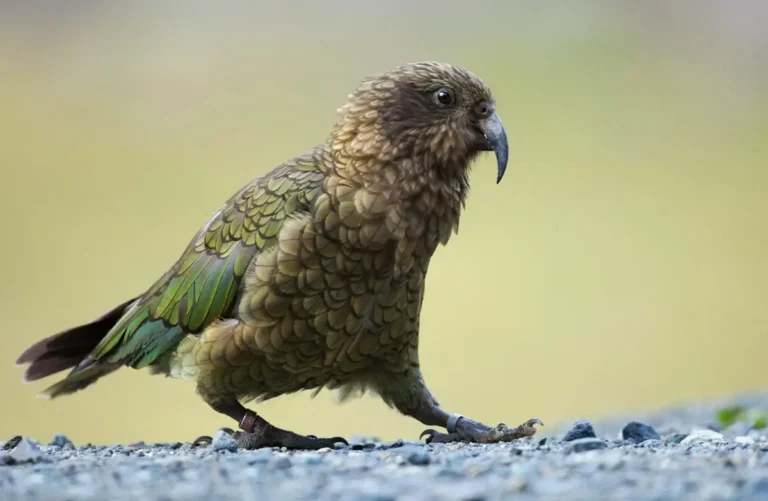Great Eared Nightjar: Habits, Habitat, and Conservation Facts
The Great Eared Nightjar (Lyncornis macrotis) is a fascinating nocturnal bird species known for its large size, striking ear tufts, and enigmatic nature. Belonging to the nightjar family (Caprimulgidae), this bird is rarely seen, owing to its remarkable camouflage and secretive behavior.
In this article, we’ll dive deep into the scientific classification, physical characteristics, habitat, behavior, diet, reproduction, predators, and conservation status of this elusive species, along with interesting facts, its evolutionary history, and its relationship with humans.
Contents
Scientific Classification
- Kingdom: Animalia
- Phylum: Chordata
- Class: Aves
- Order: Caprimulgiformes
- Family: Caprimulgidae
- Genus: Lyncornis
- Species: L. macrotis
British zoologist George Robert Gray first described the Great Eared Nightjar in 1849. It is one of the largest species within the nightjar family, easily recognizable by its distinctive ear tufts.
Physical Characteristics

The Great Eared Nightjar is medium-to-large, averaging about 31-41 cm long. Its plumage is cryptic, primarily brown and grey, allowing it to blend seamlessly into its surroundings, particularly in forested environments.
- Size: 31-41 cm in length, with a wingspan of 58-68 cm.
- Weight: Approximately 120-190 grams.
- Coloration: The plumage is mottled with shades of brown, black, and gray, providing excellent camouflage. The underparts are paler with more intricate markings.
- Distinctive Features: Its most notable feature is the large “ear” tufts (elongated feathers) that give the bird its name. These tufts stand out when the bird is alert but can be flattened against the head when resting.
- Eyes: Large and adapted for excellent night vision.
- Beak: Short but wide, ideal for catching insects mid-flight.
Habitat and Distribution
The Great Eared Nightjar is native to Southeast Asia’s dense tropical forests. Its range extends across India, Indonesia, Malaysia, Thailand, Vietnam, and the Philippines.
- Preferred Habitat: This species favors moist lowland and montane forests, often found in dense, shaded undergrowth, where its cryptic coloration helps it avoid detection.
- Altitude: It can be found from sea level up to 2,200 meters above sea level, though it typically inhabits lower elevations.
- Distribution: Found across Southeast Asia, particularly in tropical rainforests, monsoon forests, and occasionally in plantations and secondary-growth forests.
Behavior and Lifestyle
The Great Eared Nightjar is a highly secretive, nocturnal bird, most active at dusk and during the night.
- Nocturnal Lifestyle: It spends its days resting on the forest floor or low branches, relying on its camouflage to avoid predators. It becomes more active at night, flying through the forest in search of food.
- Flight: Nightjars are known for their silent, graceful flight, a trait this species shares. Its broad wings allow for slow, maneuverable flight through dense forest canopies.
- Calls: It produces a variety of vocalizations, including low, throaty sounds and occasional sharp whistles. These calls are often used during territorial displays or to communicate with potential mates.
Diet and Feeding Habits
The Great Eared Nightjar is an insectivore, feeding primarily on flying insects.
- Primary Diet: Its diet consists mainly of moths, beetles, and other nocturnal insects, which it catches in flight using its wide, gaping mouth.
- Foraging Technique: It hunts by flying low through the forest, using its excellent night vision and agile flight to snatch insects mid-air. It may also hunt from a perch, sallying out to capture passing prey.
Reproduction and Breeding
Not much is known about the breeding habits of the Great Eared Nightjar, as they are highly secretive during the breeding season.
- Nesting: Nightjars, including this species, typically do not build elaborate nests. Instead, the female lays 1-2 eggs directly on the ground, often in a small depression or amidst leaf litter.
- Incubation: The female is responsible for incubating the eggs, while the male stands guard nearby. The incubation period is thought to last around 20-21 days.
- Chicks: Upon hatching, the chicks are covered in downy feathers and are well-camouflaged. They remain motionless when threatened, blending perfectly with their surroundings until they can fly.
Predators and Threats
Due to its excellent camouflage, the Great Eared Nightjar has few natural predators. However, ground-dwelling predators such as snakes, small mammals, and large birds of prey may occasionally prey on eggs or chicks.
- Main Predators: Snakes, large birds of prey, and small carnivorous mammals.
- Threats: Habitat destruction due to deforestation poses the greatest threat to this species, as the loss of forest cover can reduce suitable breeding and feeding grounds.
Conservation Status
The Great Eared Nightjar is currently classified as a species of Least Concern on the IUCN Red List. However, deforestation and habitat loss across Southeast Asia pose a potential risk to its population.
- Conservation Measures: Preserving its natural habitat, particularly tropical forests, is crucial for survival. Conservation efforts in regions where deforestation is prevalent help ensure the stability of its population.
Evolutionary History and Interesting Facts.
- Evolutionary History: Nightjars belong to an ancient group of birds that have evolved over millions of years to specialize in nocturnal insect hunting. Their cryptic plumage and large eyes are adaptations to their nocturnal lifestyle.
- Camouflage Mastery: The great-eared Nightjar’s cryptic coloration is one of its most fascinating traits. Its ability to remain completely invisible to predators and prey is a marvel of natural selection.
- Unique Flight Pattern: Nightjars are renowned for their silent flight, which allows them to sneak up on flying insects without being detected. This flight pattern is enabled by specialized feather structures that dampen sound during wing beats.
- “Eared” But Not Really: The bird’s distinctive “ears” are not actual ears but rather feathers that create the appearance of ears. Like most birds, its real ears are small openings on the sides of its head.
Relationship with Humans
Humans do not commonly see the Great Eared Nightjar due to its elusive and nocturnal nature. However, its eerie calls have given rise to folklore and myths in areas where it is more abundant.
- Cultural Significance: In some Southeast Asian cultures, the nightjar calls are associated with spirits or omens. These birds are often believed to be messengers from the spirit world due to their nocturnal habits and mysterious vocalizations.
- Human Interaction: Nightjars are generally not threatened by human activities directly, though habitat destruction caused by logging and agriculture poses indirect threats.
Conclusion
The Great Eared Nightjar is an extraordinary bird that perfectly embodies the mystery and beauty of the night. With its unique physical characteristics, nocturnal lifestyle, and incredible camouflage abilities, it is a species well-adapted to life in the dense forests of Southeast Asia. While it is not currently under significant threat, preserving its forest habitat is vital to its survival. As we continue to learn more about this enigmatic bird, it serves as a reminder of the complexity and wonder of the natural world.
- Golden Retriever Pros and Cons: What Every Pet Parent Should Know - 15 September 2025
- Cane Corso Dog Breed: Health, Care, and Lifespan - 14 September 2025
- Catahoula Leopard Dogs: Description, Temperament, Lifespan, & Facts - 21 July 2025







